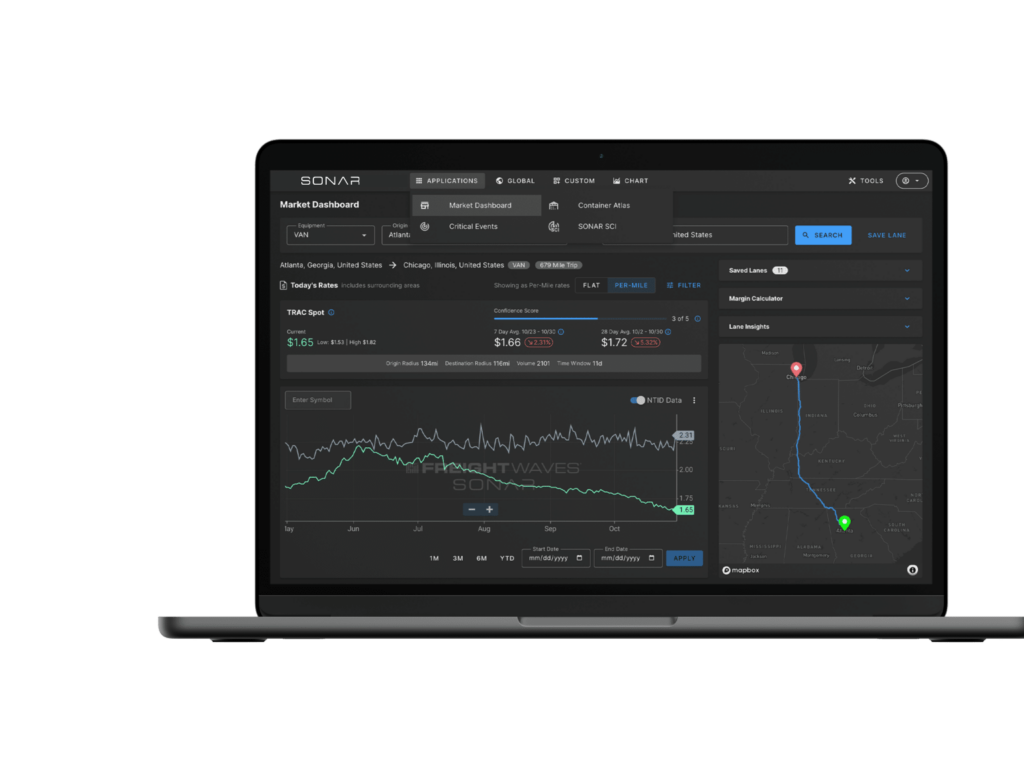Excel analysis of the new SONAR tool shows how truckload competes with rail intermodal by lane
Prior to last month, SONAR data was available in two ways: by using the browser-based visualization tool or via an API connection. SONAR customers that perform complex analyses, such as regressions between SONAR data and their own proprietary data, have historically opted to pull data directly via API, but not everyone has a data science team behind them to assist with technicalities.
It’s clear to us that many folks feel much more at home working in Excel. Adding the Excel Add-in to SONAR’s capabilities makes it possible to create custom spreadsheets for a wider range of users.
That includes myself. Using the Excel Add-in, I created a custom analysis for a quick look at the relative competitiveness between truckload and intermodal in the 15 most dense domestic intermodal lanes. I used spot rates but anticipate updating to use contract rates instead when intermodal contract rates become productized in SONAR. I recommend that multimodal shippers modify this analysis to instead use only the lanes where it actively moves loads as a first screen to see potential conversion truckload to intermodal conversion opportunities.

The degree of competitiveness between truckload and domestic rail intermodal is mixed by lane. Source: SONAR
Lanes where intermodal has a clear cost advantage are deemed to have a low degree of competition with truckload in the above table. At the other end of the spectrum, lanes where rates are within 10% of parity are those where intermodal carriers are at risk of losing loads to the highway and are deemed high in relative competitiveness.
The table above compares truckload and intermodal by bringing together three distinct SONAR data sets: loaded domestic intermodal volume using the ORAIL data set, intermodal spot rates using the INTRM data set and dry van spot rates using the TRAC/Market Dashboard data set. Note that dry van rates do not match what is currently being shown in the SONAR Market Dashboard app because they are based on key market area (KMA) rather than city center.

Source: SONAR
I selected the 15 lanes with the greatest domestic intermodal density, starting with LA to Chicago. The current loaded volume in the lane is 86% of the 52-week high. That data point and the muted intermodal spot rate of $1.17/mile, including fuel, suggest there is available intermodal capacity in the lane. While a small minority of intermodal volume moves on the spot market, the intermodal spot rate from LA to Chicago, including fuel, offers a compelling 36% savings relative to the dry van spot rate pulled from TRAC/Market Dashboard of $1.86/mile, which also includes fuel. Therefore, it would be hard for a truckload carrier to compete in that lane on the basis of price. Thus, truckload is deemed to have a low degree of competitiveness with rail intermodal. Other lanes with low competitiveness include headhaul lanes from the ports, such as LA to Dallas and Oakland to Chicago, as well as backhaul lanes where containers are being repositioned, such as Chicago to LA.

Source: SONAR
The Harrisburg to Chicago lane, the 10th densest domestic intermodal lane, is a more highly competitive one. While the intermodal spot rate quote in SONAR (INTRM.CHM) is a reasonable $1.38/mile (including fuel), that is within 9% of the $1.52/mile (including fuel) that brokers are paying for spot capacity, according to the SONAR Trusted Rate Assessment Consortium (TRAC). Since service is also a consideration, a 9% savings might not be enough to entice shippers to opt for rail/intermodal. The Chicago to Dallas lane also appears to be highly competitive when comparing rates across modes, with truckload spot rates actually below intermodal spot rates when fuel is included for both.
In our analysis, four lanes stand out as having a medium degree of competitiveness between truckload and intermodal — Chicago to Harrisburg, Chicago to Newark, Chicago to Atlanta and Dallas to Chicago. That’s intuitive because each of those routes can be completed on the highway within two days. The routes take longer when intermodal is used, so the 10–20% spread represents a trade-off between cost and service.
To learn more about the Excel Add-in, submit a demo request to see how you can utilize it at your organization!











